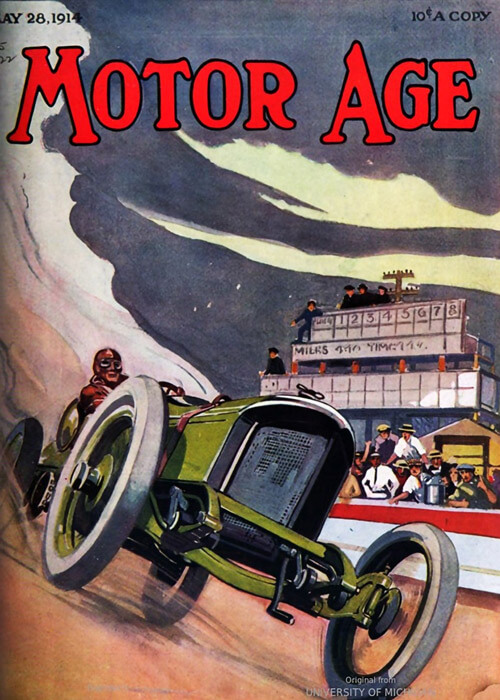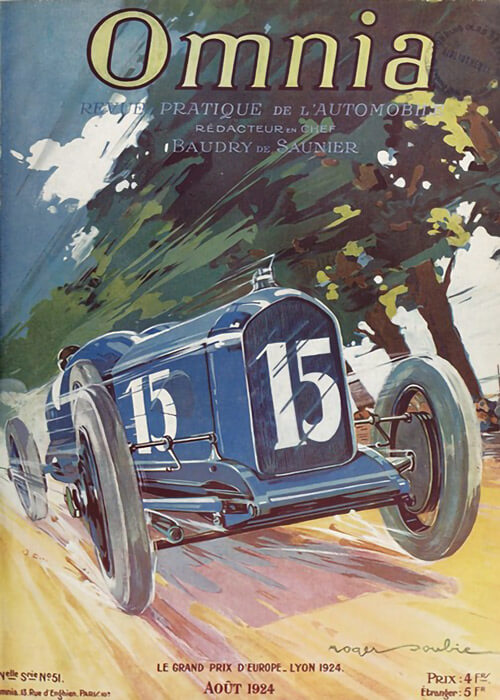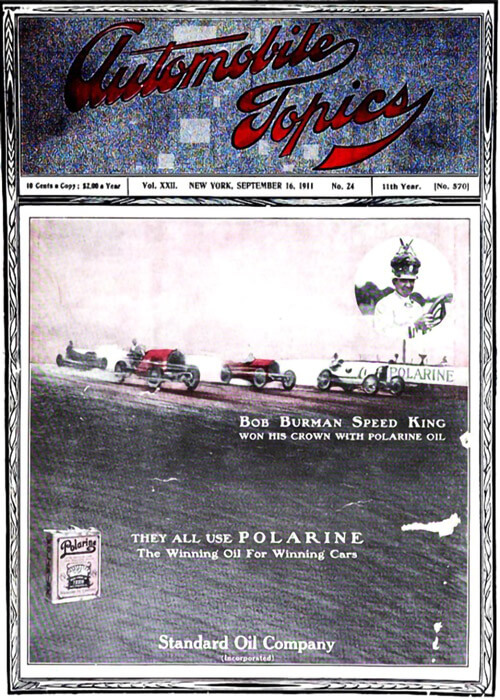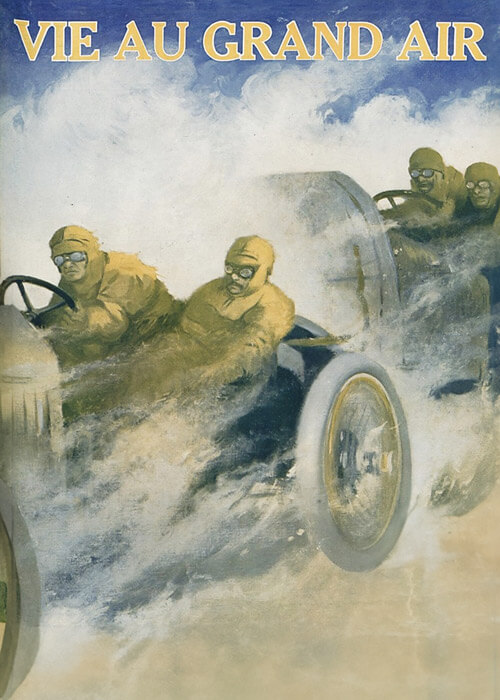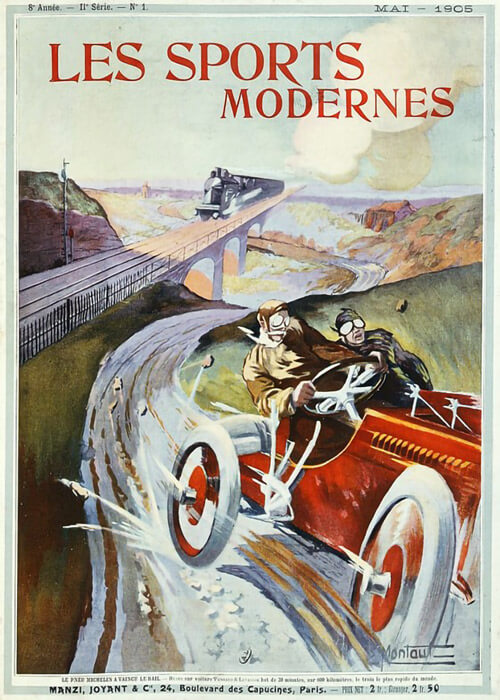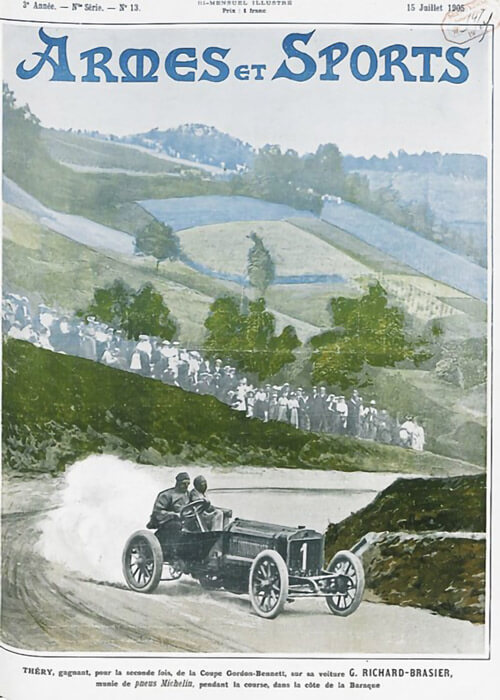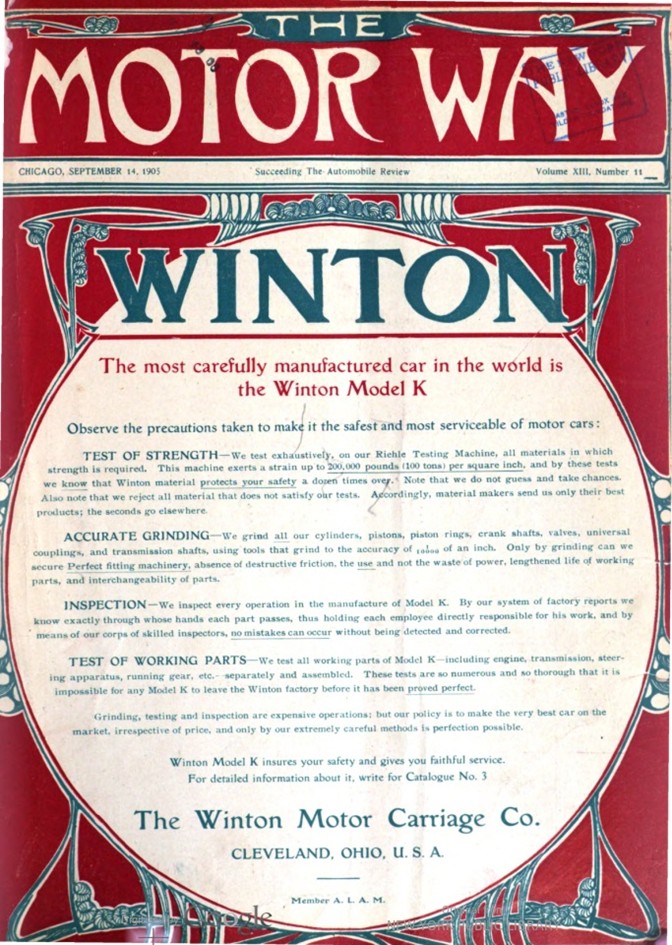
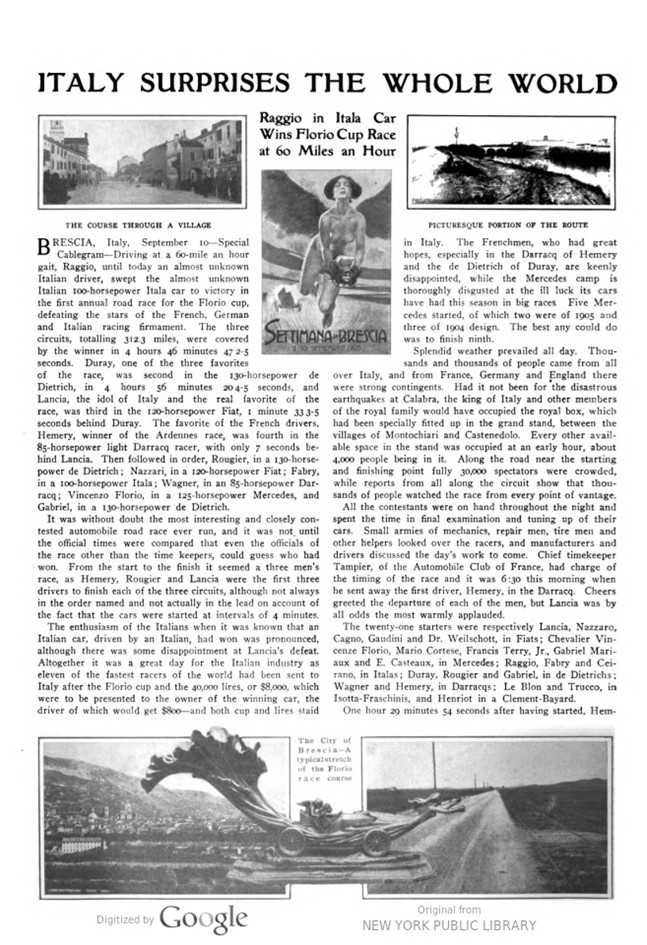
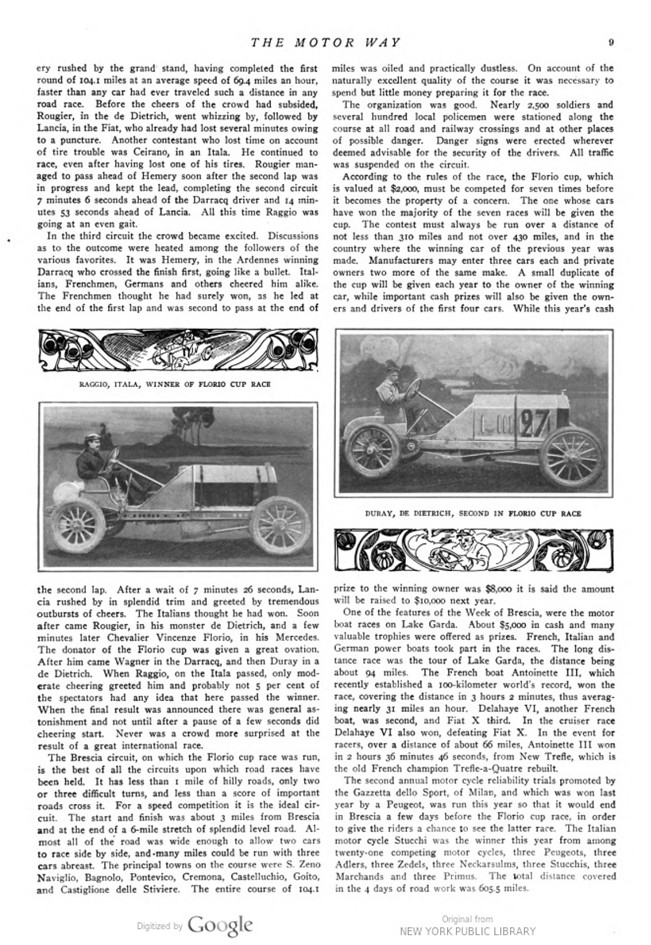
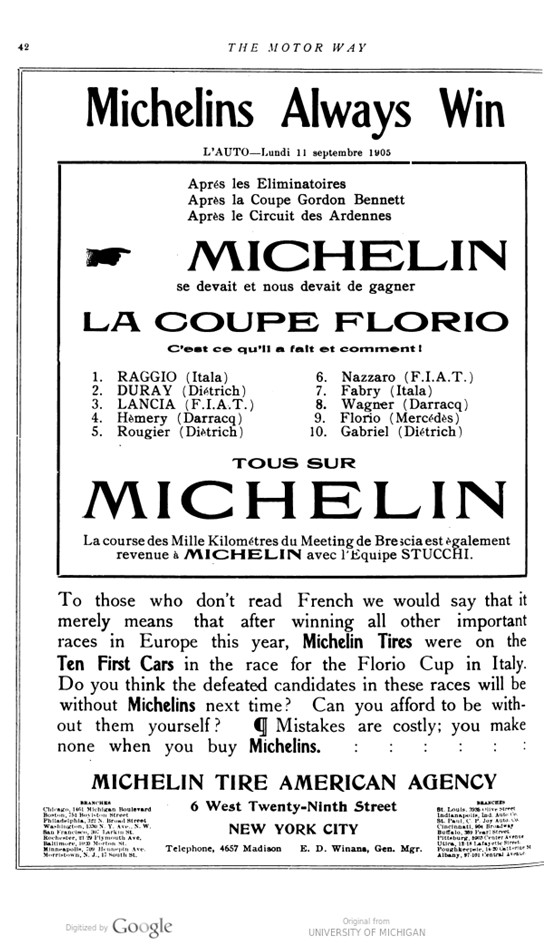
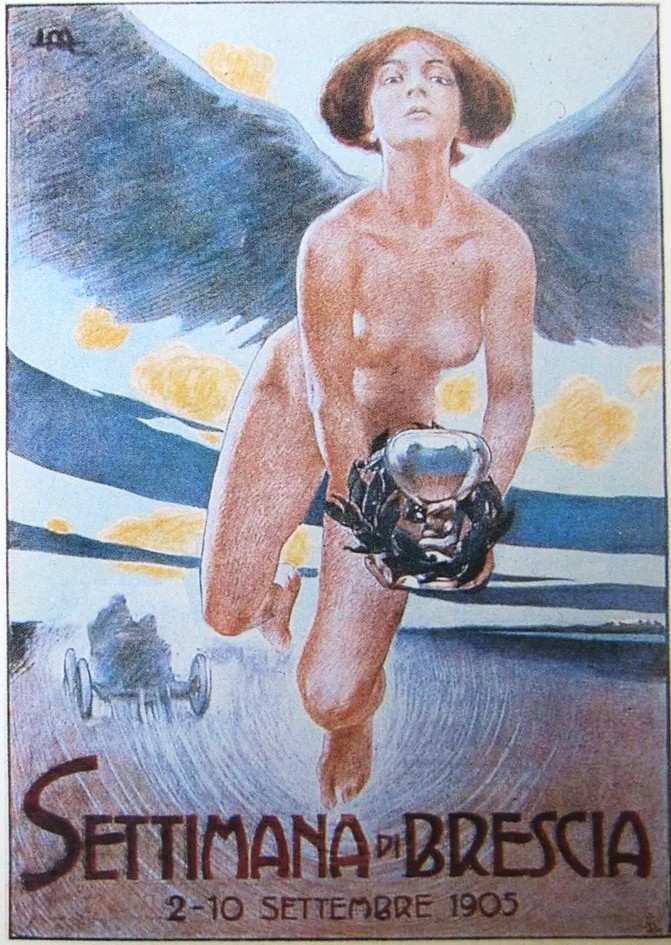
Text and pictures with courtesy of hathitrust.org, compiled by motorracinghistory
The Motor Way – Vol. 13, No. 11, September 14 1905
ITALY SURPRISES THE WHOLE WORLD
Raggio in Itala Car Wins Florio Cup Race at 60 Miles an Hour.
SETTIMANA BRESCIA 2-10 SETTEMBRE 1905
BRESCIA, Italy, September 10-Special Cablegram-Driving at a 60-mile an hour gait, Raggio, until today an almost unknown Italian driver, swept the almost unknown Italian 100-horsepower Itala car to victory in the first annual road race for the Florio cup, defeating the stars of the French, German and Italian racing firmament. The three circuits, totaling 312.3 miles, were covered by the winner in 4 hours 46 minutes 47 2-5 seconds. Duray, one of the three favorites of the race, was second in the 130-horsepower de Dietrich, in 4 hours 56 minutes 20 4-5 seconds, and Lancia, the idol of Italy and the real favorite of the race, was third in the 120-horsepower Fiat, I minute 33 3-5 seconds behind Duray. The favorite of the French drivers, Hemery, winner of the Ardennes race, was fourth in the 85-horsepower light Darracq racer, with only 7 seconds behind Lancia. Then followed in order, Rougier, in a 130-horsepower de Dietrich; Nazzari, in a 120-horsepower Fiat; Fabry, in a 100-horsepower Itala; Wagner, in an 85-horsepower Darracq; Vincenzo Florio, in a 125-horsepower Mercedes, and Gabriel, in a 130-horsepower de Dietrich.
It was without doubt the most interesting and closely contested automobile road race ever run, and it was not until the official times were compared that even the officials of the race other than the timekeepers, could guess who had won. From the start to the finish, it seemed a three men’s race, as Hemery, Rougier and Lancia were the first three drivers to finish each of the three circuits, although not always in the order named and not actually in the lead on account of the fact that the cars were started at intervals of 4 minutes. The enthusiasm of the Italians when it was known that an Italian car, driven by an Italian, had won was pronounced, although there was some disappointment at Lancia’s defeat. Altogether it was a great day for the Italian industry as eleven of the fastest racers of the world had been sent to Italy after the Florio cup and the 40,000 lires, or $8,000, which were to be presented to the owner of the winning car, the driver of which would get $800-and both cup and lires staid in Italy. The Frenchmen, who had great hopes, especially in the Darracq of Hemery and the de Dietrich of Duray, are keenly disappointed, while the Mercedes camp is thoroughly disgusted at the ill luck its cars have had this season in big races. Five Mercedes started, of which two were of 1905 and three of 1904 design. The best any could do was to finish ninth.
Splendid weather prevailed all day. Thousands and thousands of people came from all over Italy, and from France, Germany and England there were strong contingents. Had it not been for the disastrous earthquakes at Calabra, the king of Italy and other members of the royal family would have occupied the royal box, which had been specially fitted up in the grandstand, between the villages of Montochiari and Castenedolo. Every other available space in the stand was occupied at an early hour, about 4,000 people being in it. Along the road near the starting and finishing point fully 30,000 spectators were crowded, while reports from all along the circuit show that thou- sands of people watched the race from every point of vantage.
All the contestants were on hand throughout the night and spent the time in final examination and tuning up of their cars. Small armies of mechanics, repair men, tire men and other helpers looked over the racers, and manufacturers and drivers discussed the day’s work to come. Chief timekeeper Tampier, of the Automobile Club of France, had charge of the timing of the race and it was 6:30 this morning when he sent away the first driver, Hemery, in the Darracq. Cheers greeted the departure of each of the men, but Lancia was by all odds the most warmly applauded.
The twenty-one starters were respectively Lancia, Nazzaro, Cagno, Gaudini and Dr. Weilschott, in Fiats; Chevalier Vincenze Florio, Mario Cortese, Francis Terry, Jr., Gabriel Mariaux and E. Casteaux, in Mercedes; Raggio, Fabry and Ceirano, in Italas; Duray, Rougier and Gabriel, in de Dietrichs; Wagner and Hemery, in Darracqs; Le Blon and Trucco, in Isotta-Fraschinis, and Henriot in a Clement-Bayard. One hour 29 minutes 54 seconds after having started, Hemery rushed by the grand stand, having completed the first round of 104.1 miles at an average speed of 69.4 miles an hour, faster than any car had ever traveled such a distance in any road race. Before the cheers of the crowd had subsided, Rougier, in the de Dietrich, went whizzing by, followed by Lancia, in the Fiat, who already had lost several minutes owing to a puncture. Another contestant who lost time on account of tire trouble was Ceirano, in an Itala. He continued to race, even after having lost one of his tires. Rougier managed to pass ahead of Hemery soon after the second lap was in progress and kept the lead, completing the second circuit 7 minutes 6 seconds ahead of the Darracq driver and 14 minutes 53 seconds ahead of Lancia. All this time Raggio was going at an even gait.
In the third circuit the crowd became excited. Discussions as to the outcome were heated among the followers of the various favorites. It was Hemery, in the Ardennes winning Darracq who crossed the finish first, going like a bullet. Italians, Frenchmen, Germans and others cheered him alike. The Frenchmen thought he had surely won, as he led at the end of the first lap and was second to pass at the end of the second lap. After a wait of 7 minutes 26 seconds, Lancia rushed by in splendid trim and greeted by tremendous outbursts of cheers. The Italians thought he had won. Soon after came Rougier, in his monster de Dietrich, and a few minutes later Chevalier Vincenze Florio, in his Mercedes. The donator of the Florio cup was given a great ovation. After him came Wagner in the Darracq, and then Duray in a de Dietrich. When Raggio, on the Itala passed, only moderate cheering greeted him and probably not 5 per cent of the spectators had any idea that here passed the winner. When the final result was announced there was general astonishment and not until after a pause of a few seconds did cheering start. Never was a crowd more surprised at the result of a great international race.
The Brescia circuit, on which the Florio cup race was run, is the best of all the circuits upon which road races have been held. It has less than 1 mile of hilly roads, only two or three difficult turns, and less than a score of important roads crosses it. For a speed competition it is the ideal ciruit. The start and finish was about 3 miles from Brescia and at the end of a 6-mile stretch of splendid level road. Almost all of the road was wide enough to allow two cars to race side by side, and many miles could be run with three cars abreast. The principal towns on the course were S. Zeno Naviglio, Bagnolo, Pontevico, Cremona, Castelluchio, Goito, and Castiglione delle Stiviere. The entire course of 104.1 miles was oiled and practically dustless. On account of the naturally excellent quality of the course it was necessary to spend but little money preparing it for the race.
The organization was good. Nearly 2,500 soldiers and several hundred local policemen were stationed along the course at all road and railway crossings and at other places of possible danger. Danger signs were erected wherever deemed advisable for the security of the drivers. All traffic was suspended on the circuit.
According to the rules of the race, the Florio cup, which is valued at $2,000, must be competed for seven times before it becomes the property of a concern. The one whose cars have won the majority of the seven races will be given the cup. The contest must always be run over a distance of not less than 310 miles and not over 430 miles, and in the country where the winning car of the previous year was made. Manufacturers may enter three cars each and private owners two more of the same make. A small duplicate of the cup will be given each year to the owner of the winning car, while important cash prizes will also be given the owners and drivers of the first four cars. While this year’s cash prize to the winning owner was $8,000 it is said the amount will be raised to $10,000 next year.
One of the features of the Week of Brescia, were the motorboat races on Lake Garda. About $5,000 in cash and many valuable trophies were offered as prizes. French, Italian and German power boats took part in the races. The long distance race was the tour of Lake Garda, the distance being about 94 miles. The French boat Antoinette III, which recently established a 100-kilometer world’s record, won the race, covering the distance in 3 hours 2 minutes, thus averaging nearly 31 miles an hour. Delahaye VI, another French boat, was second, and Fiat X third. In the cruiser race Delahaye VI also won, defeating Fiat X. In the event for racers, over a distance of about 66 miles, Antoinette III won in 2 hours 36 minutes 46 seconds, from New Trefle, which is the old French champion Trefle-a-Quatre rebuilt.
The second annual motorcycle reliability trials promoted by the Gazzetta dello Sport, of Milan, and which was won last year by a Peugeot, was run this year so that it would end in Brescia a few days before the Florio cup race, in order to give the riders a chance to see the latter race. The Italian motor cycle Stucchi was the winner this year from among twenty-one competing motor cycles, three Peugeots, three Adlers, three Zedels, three Neckarsulms, three Stucchis, three Marchands and three Primus. The total distance covered in the 4 days of road work was 605.5 miles.
Photo captions
PICTURESQUE PORTION OF THE ROUTE
THE COURSE THROUGH A VILLAGE
The City of Brescia – A typical stretch of the Florio racecourse.
RAGGIO, ITALA, WINNER OF FLORIO CUP RACE
DURAY, DE DIETRICH, SECOND IN FLORIO CUP RACE
